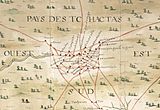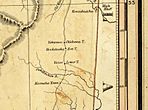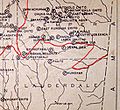Coosha facts for kids
Quick facts for kids |
|
|
Coosha
|
|
| Lua error in Module:Location_map at line 420: attempt to index field 'wikibase' (a nil value). | |
| Nearest city | Lizelia, Mississippi |
|---|---|
| Area | 14 acres (5.7 ha) |
| NRHP reference No. | 78001608 |
| Added to NRHP | November 21, 1978 |
Coosha, also called Coosha Town, was an old village of the Choctaw people in Lauderdale County, Mississippi. It was one of many "Coosha towns" that formed the Eastern part of the Choctaw Nation long before Europeans settled in America. People stopped living in Coosha in the mid-1800s. In 1978, it was added to the National Register of Historic Places (NRHP), which lists important historical sites.
Contents
What's in a Name? Coosha's Story
The name "Coosha" comes from the Choctaw words "Kushak" or "Kusha." These words mean "reed" or "reed-brake." This area near the headwaters of the Chickasawhay River was once covered in tall reeds.
The reeds were so tall that Choctaw people could hide horses there. These horses were often stolen from plantations by white thieves. Because of this, a nearby creek was named "Issuba in Kannia bok," which means "Lost Horse Creek" in English.
You might see the town's name spelled in different ways. "Koonsha" is a common English spelling. Other spellings include "Coucha," "Kunshak," "Coonsha," "Conshaques," or "Concha." The official database for the National Register of Historic Places uses "Coosha."
("Kunshak")
Coosha appears on many old maps. It is called "Concha" on a 1733 map by Baron de Crenay. On an 1820 map by Henry Schenck Tanner, it is shown as "Koomsha Town." A 1931 map by John R. Swanton spells the name "Kunshak."
Where Was Coosha Located?
Even though Coosha is on many old maps, its exact location is not fully known. Some historians say it was near today's Naval Air Station Meridian. This is close to Daleville, Mississippi.
Other sources place the settlement about four miles southeast of "Old Daleville." This area is now known as Lizelia, Mississippi. Both sources agree that Coosha was near Lost Horse Creek. This creek is a small river that flows into Ponta Creek.
The village stretched along a high bank for about 1 mile (1.6 km) to 2.5 miles (4.0 km) along Lost Horse Creek. Two parts of the creek join together in a specific area. Coosha was located on the north side of the western part of the creek. When Coosha was added to the National Register of Historic Places in 1978, its exact address was kept secret. This was done to protect the site from people who might try to steal historical items.
Some of the confusion about Coosha's name and location comes from there possibly being more than one village with the same name. Also, other towns along Ponta Creek were generally called "Coosha towns." So, early writers might have mixed up the general term with the specific village of Coosha.
Coosha's History: A Look Back
Coosha has a long history, going back to at least the 1700s, and maybe even earlier. In 1925, a researcher named Henry B. Collins found graves at the site. He believed these graves were from between 1800 and 1830.
Other items found at the site date back as far as 500 BCE. However, the Choctaw people who lived in Coosha were likely the first humans to settle there in a long time.
The Rise of the Choctaw Nation
The Choctaw people came together as a nation in the 1500s and 1600s. They were a mix of earlier groups known as Mississippian cultures. One group, called the Burial Urn people, slowly moved into the Coosha area. They came from the Bottle Creek Indian Mounds area in Alabama.
Another group came from the Moundville chiefdom, which had fallen apart in the mid-1300s. These groups faced many challenges, including diseases brought by Europeans. They moved west and met other groups, like the Plaquemines. Over several generations, these different groups combined to form the new society known as the Choctaw.
By the early 1700s, the Choctaw had divided into three main political areas. The Burial Urn people likely first lived in the Coosha and Chickasawhay towns. These towns made up the Eastern District. Other groups lived in what became the Southern District, also called the Six Towns District. A third group formed the Western District.
Life in Coosha Village
The Coosha towns in the Eastern District included about forty or fifty villages. At its busiest time, the main Coosha village had around 1200 people. The village had fruit trees like peaches and plums. Animals like bear, deer, turkey, squirrels, and wild cats lived nearby. Small gardens with maize (corn) were scattered throughout the village's small settlements.
One of the most famous people linked to Coosha is the chief Pushmataha. He was a leader, or "mingo," of the Coosha towns for a short time. Pushmataha's nephew, Oklahoma, became the next mingo. After Oklahoma died in 1846, the village of Coosha seems to have been left empty.




